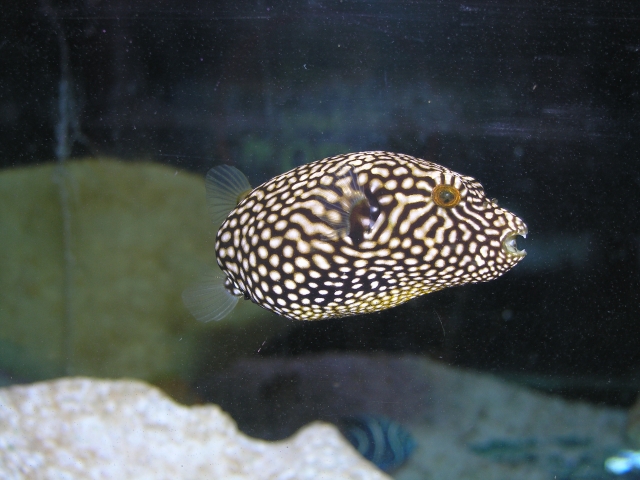
They also have four teeth that are fused together into a beak-like form.ĭiet includes mostly invertebrates and algae. They are scaleless fish and usually have rough to spiky skin. It would be just my luck.They range in size from the 1-inch-long dwarf or pygmy puffer to the freshwater giant puffer, which can grow to more than 2 feet in length. Not good to be leaking blood underwater with other fish around with jaws even worse than my pufferfish! And naturally, it wouldn't let go, for what seemed an eternity.Įnd of dive, beginning of a few days of painkillers. It proceeded to crush my forefinger behind the first knuckle, bone and all. At first there was a fairly gentle squeezing, but some species graze on coral and they have a hydraulic compression system in their jaw muscles for grinding coral. This was completely unacceptable to the pufferfish and it objected by grabbing my right forefinger. I was holding it by the tail with my left hand and trying to direct it with my right hand to "pose" for a photo for my dive buddy. I was diving on the Great Barrier reef on a three day outing when I caught a big one underwater after it had puffed up. My only bad experience with a pufferfish wasn't in the eating. You basically pay a lot for the thrill and the taste of the soy-based dipping sauce. * Last, the reality of fugu is that it's kind of cool in a "has an aura of risk without any actual danger" to it, but it's basically a firm white-meat fish with not much taste, served in paper-thin slices for rather too much money for it to be worth it. Fatalities from eating fish from a licensed place simply is unheard of I don't know of a single incident in recent times, and it's not a very rare dish either.
#Florida puffer fish how to#
These are always, invariably, from some idiot sports fisherman thinking he knows how to clean a pufferfish from looking at a diagram in a book, botching the process, and killing himself and his macho pals. * There are a few fatalities every year from eating Fugu typically half a dozen or less. The news broadcasts report on the fatalities and near-misses around the second or third of January every year. They're eaten by most people on New Year as part of a traditional soup, and the very sticky consistency (think golfball-sized gluestick ball with nice flavour) means there's dozens of elderly people choking to death on them every year. By far, the big killer is mochi - sticky rice balls. * the most dangerous food in Japan, as measured by fatalities, is not Fugu, not by a long shot. Regarding Fugu, the Japanese puffer fish, it's worth noting three facts: If you eat a puffer fish you should place yourself immediately under the care of a doctor: a psychiatrist. The FDA guidance on eating puffer fish says it is OK to eat puffer fish if you know it has been properly prepared or comes from the mid-Atlantic region of the US.

North of Virginia, marine coastal puffer fish have not yet been shown to have toxin, but neither has systematic monitoring assured all are toxin free. Florida, for example, bans commercial and recreational fishing for puffer fish in most waters and these fish have toxin regardless of processing. Some puffer fish caught in the US have toxin and some don't.

The Japanese government regulates and certifies processors and Japanese processed puffer fish meat has been exported to other countries, including the US, where a single importer sells it to restaurants. This is possible because most of the toxin(s) are found in the liver, ovaries or testes, intestine or skin, so the fish meat skilled processors can prepare the fish by removing these organs in ways that prevent the rest of the fish from being contaminated. You can improve your chances living to eat another meal, however, if you know the fish has been caught in an area where the fish are toxin-free or are fish that have been specially prepared to prevent the edible flesh from being contaminated with these potent toxins. So pufferfish meals have always have a little extra frisson associated with them. But you can't tell from looking at it if they are the deadly kind. Not all puffer fish have toxin (NB: puffer fish are also called fugu, bok, blowfish, globefish, swellfish, balloonfish, or sea squab). In severe intoxications, death can result from respiratory paralysis. Initial symptoms include tingling of the lips and mouth, followed by dizziness, tingling in the extremities, problems with speaking, balance, muscle weakness and paralysis, vomiting, and diarrhea. Considerable delicacy in Japan (a taste adopted by some non-Japanese Foodies), they come with a side of risk: some puffer fish have the potent lethal toxins tetrodotoxin and/or saxitoxin, neurotoxins more than 1000 times the lethal potency of cyanide: Symptoms start within 20 minutes to 2 hours after eating the toxic fish.


 0 kommentar(er)
0 kommentar(er)
